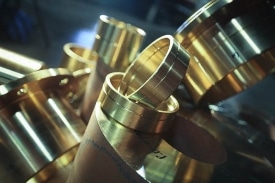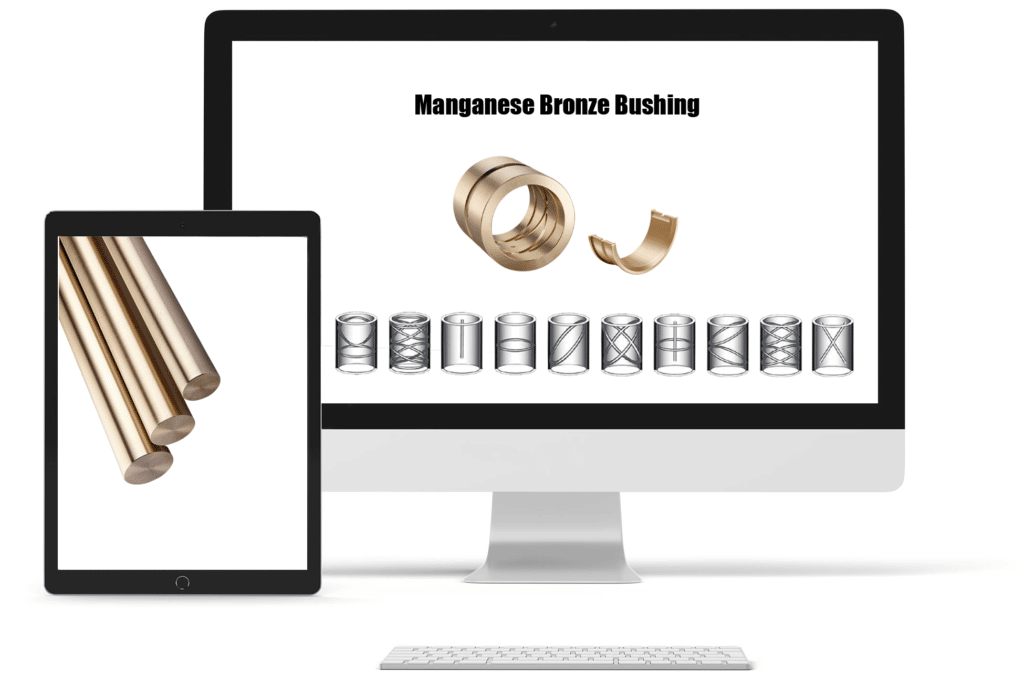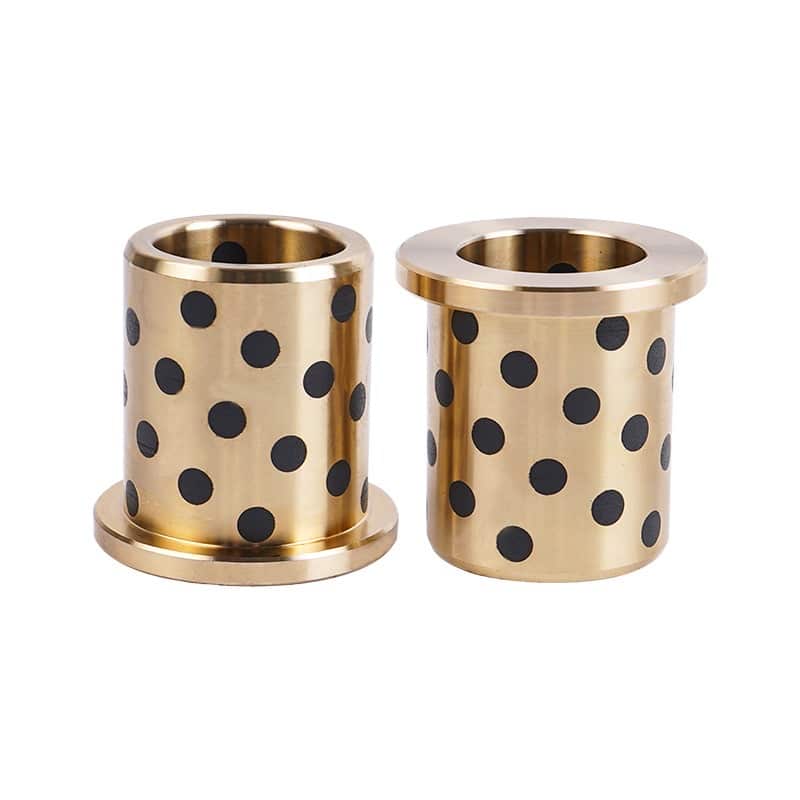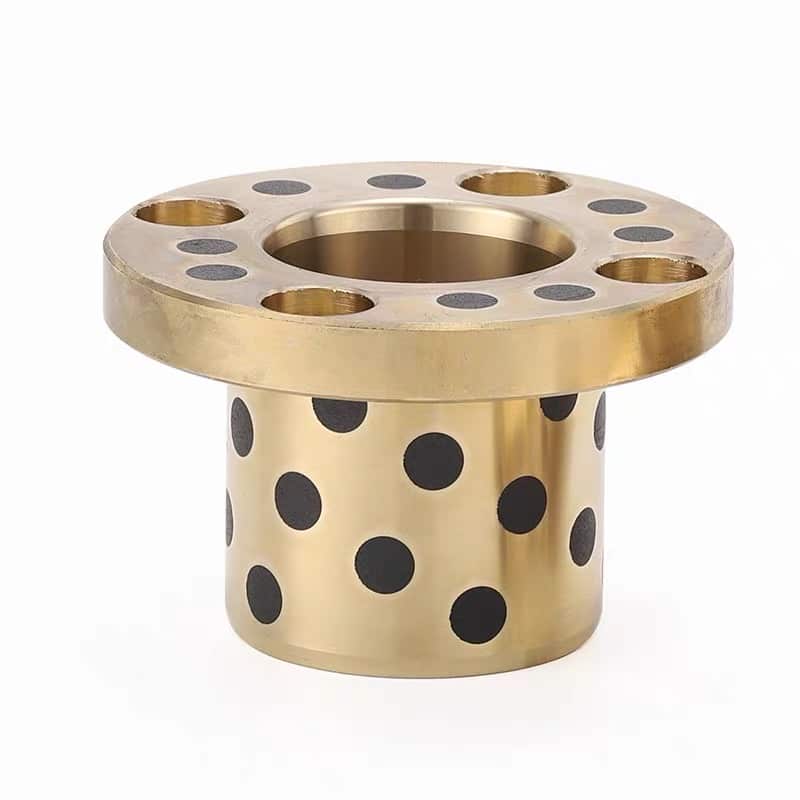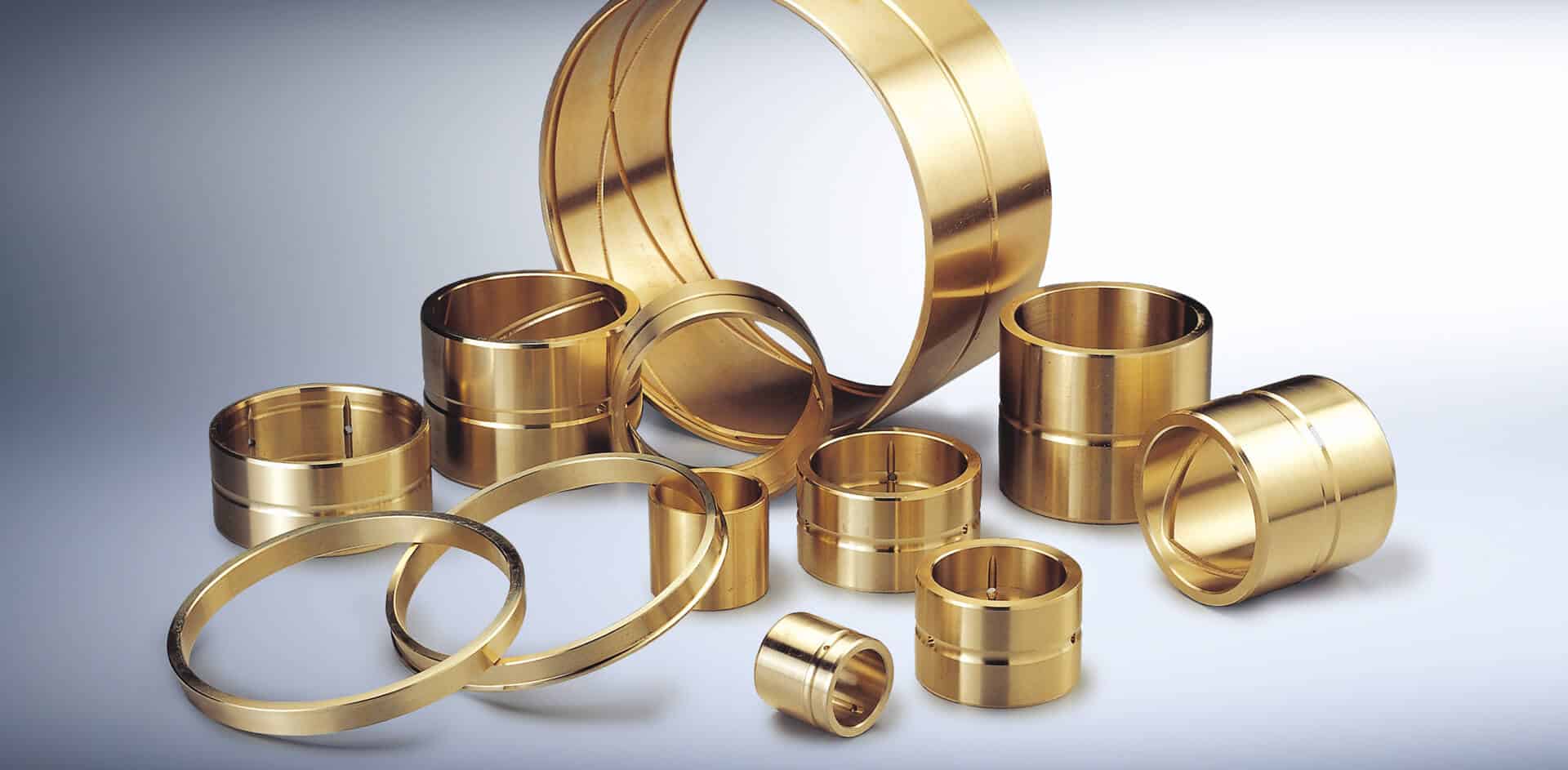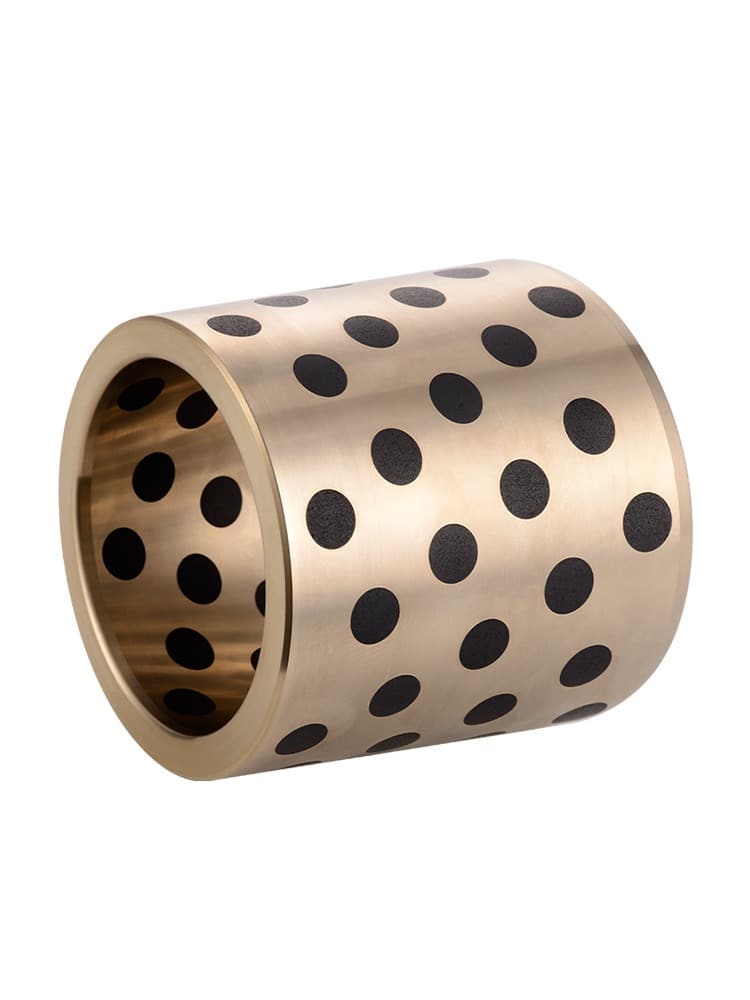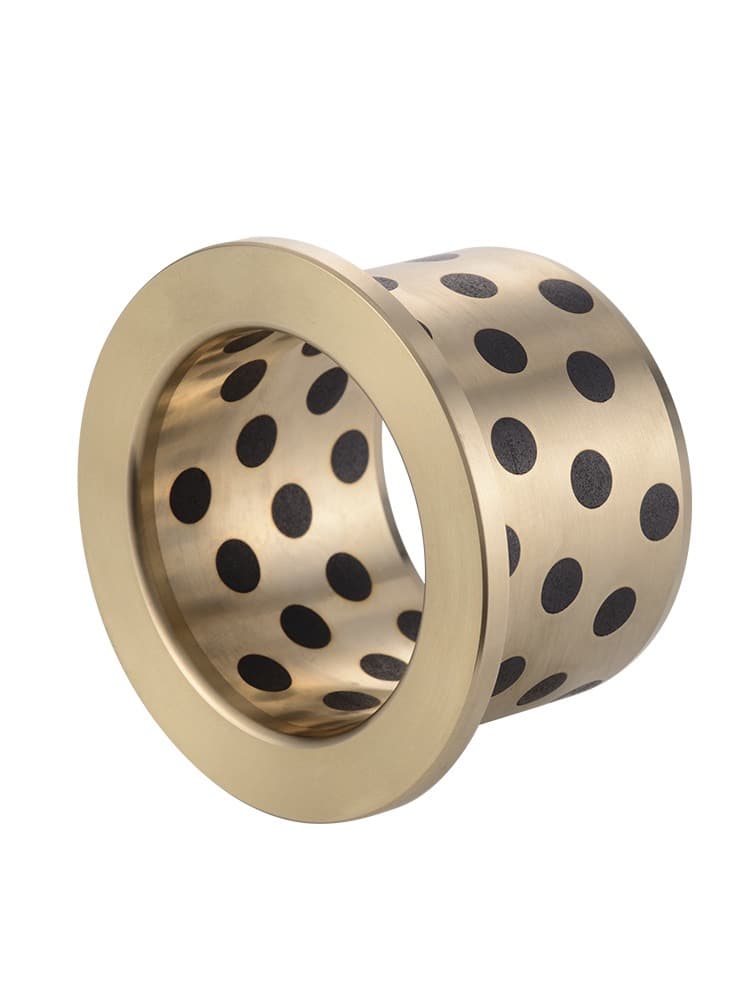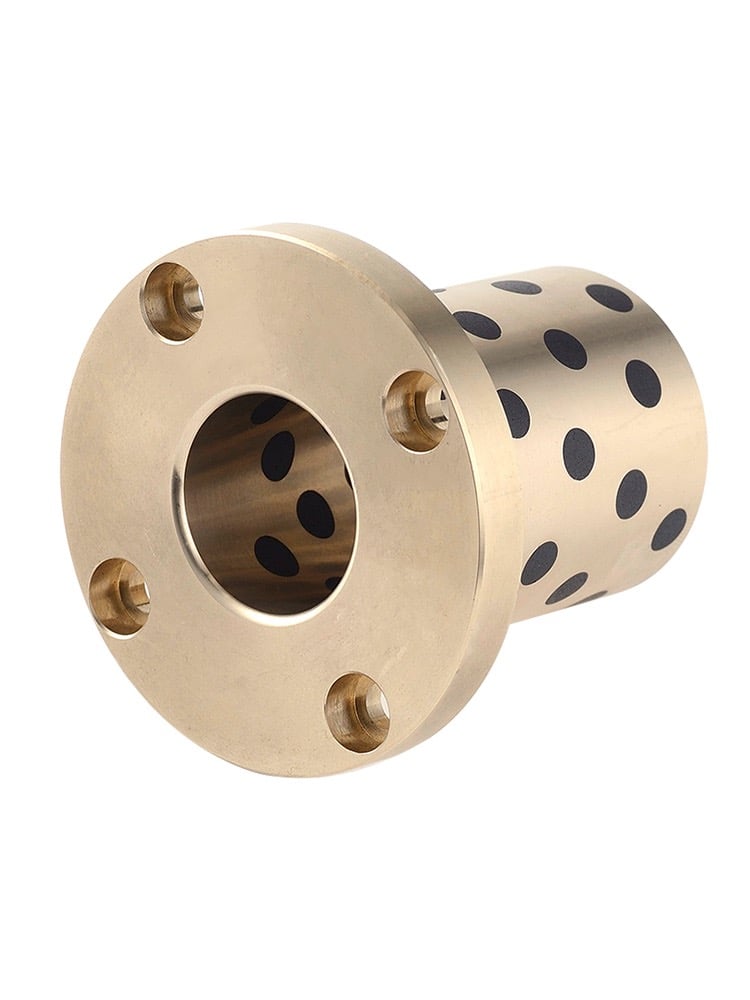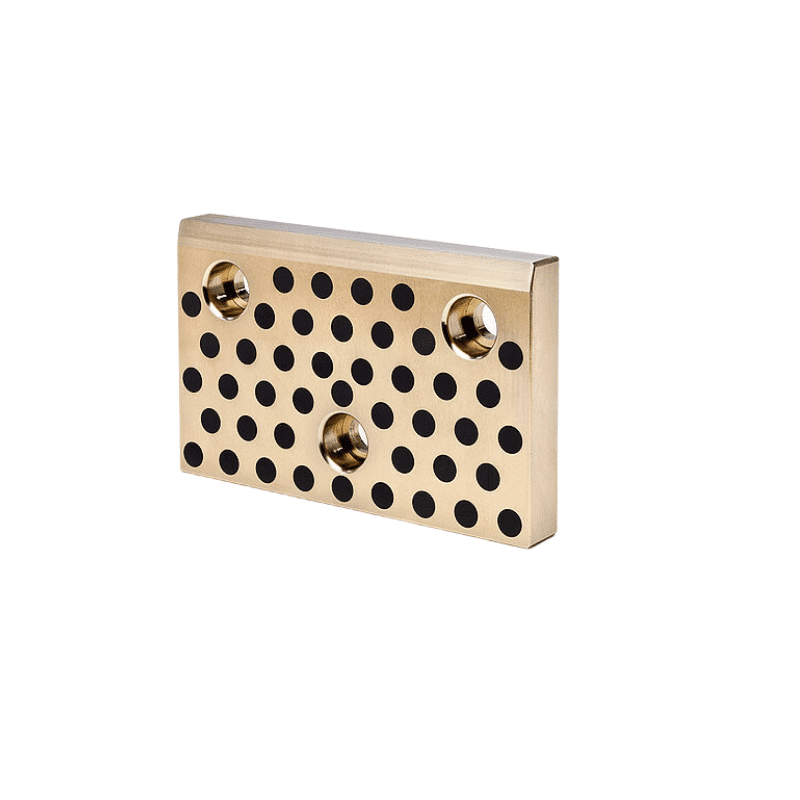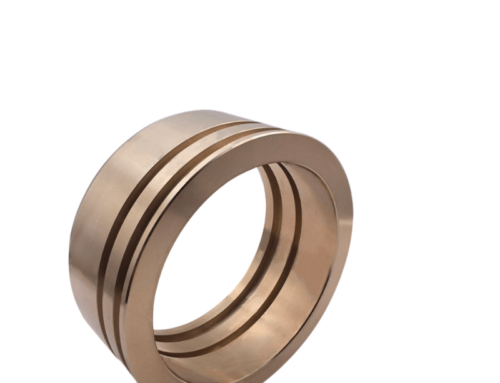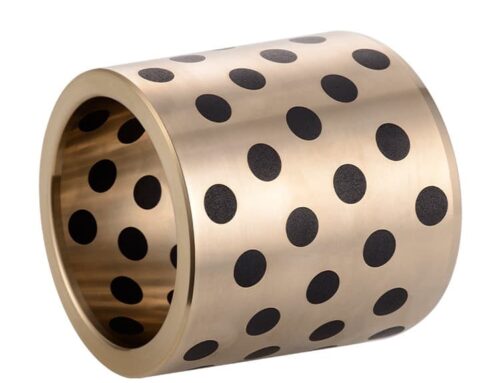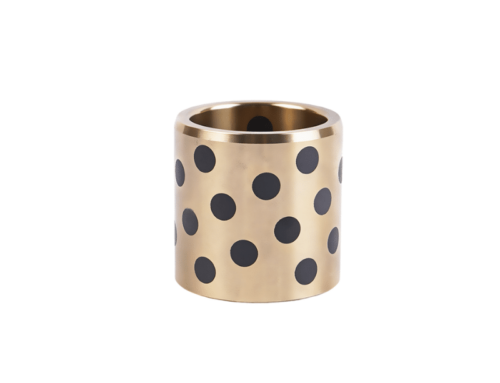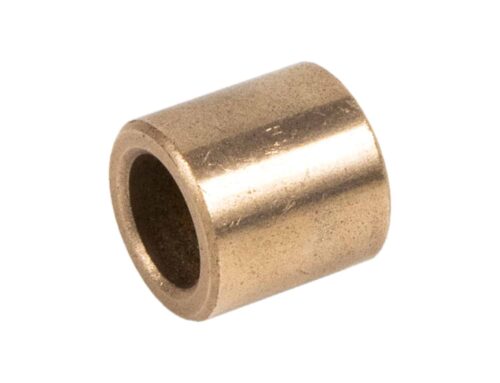Manganese Bronze Bushing, custom machined bronze parts manufacturer.
Trusted Supplier of Manganese Bronze Bushings
Bronzelube is a china supplier of manganese bronze bushings, offering standard and custom sizes at competitive prices while maintaining high-quality standards. We provide C86300 (SAE 430B) manganese bronze bushings with a smooth finish. With a variety of materials available, our durable bushings ensure reliable and affordable solutions, making Bronzelube the ideal choice for your self-lubricated part needs.
Manganese Bronze Bearing Bushing: Overview of Material and Applications
Manganese bronze bearing bushings are self-lubricating bearings composed of a copper, zinc, and manganese alloy. They are well-suited for heavy-duty applications involving high loads and low speeds, often found in marine and industrial machinery. The Bronze Company guarantees its Manganese Bronze Bearing & Bushing products, detailing their materials and applications.
Copper, Brass, & Bronze Alloy Shapes
Differential Expansion & Re-Optimization in Bronze Alloy Bearing Bushings: A Guide to Manganese Bronze Alloys
Discover how manganese bronze alloys like C86300, C86500, and C86100 excel in bearing bushings.
Manganese bronze alloys are available in various grades, each with a specific code and set of properties. Some of the notable manganese bronze alloy grades and their corresponding codes are:
C86500 Manganese Bronze: This grade is part of the manganese bronze and leaded manganese bronze alloy family, known for its high strength and durability. It is used in various applications, including casting.
C86300 Manganese Bronze (SAE 430B): This alloy is a high-strength, non-heat treatable copper alloy. It is designated with standards such as ASTM B-62, ASTM B-271, ASTM B-505, ASTM B-584, ASTM B-145/4A, SAE 461, SAE J462, SAE 40, AMS 4085, AMS 4855B, and DIN 2.1096.01. It is suitable for applications requiring a good combination of wear resistance and strength.
C67300 Manganese Bronze (SAE J463): Often referred to as a manganese brass due to the use of zinc as the alloying element, C67300 exhibits excellent wear and tear characteristics and is easily machinable. It is often used as an alternative for phosphor bronze in demanding applications.
UNS C86100 Manganese Bronze: This copper casting alloy is recommended for various casting methods, including centrifugal, investment, plaster, and sand. It is commonly used in marine applications, such as for gears, gun mounts, bushings, bearings, and marine racing propellers.
Additional Codes: Other manganese bronze alloy grades include C86200, C86400, C86700, and C99700. These are mentioned in safety data sheets and are used in various manufacturing applications.
Each of these grades has specific properties and applications, making them suitable for different industrial and manufacturing needs.
The Critical Role of Material Choice in Bearing Bushings
Bearing bushings are vital components in machinery, reducing friction and wear under heavy loads. Selecting the right alloy ensures longevity and performance. Manganese bronze alloys, known for their high strength, wear resistance, and corrosion tolerance, are top choices. However, factors like differential expansion (uneven thermal expansion under temperature changes) and re-optimization (adjusting design/material for enhanced performance) are critical for success.
This guide explores key manganese bronze grades, their properties, and how to leverage them for thermal stability and durability.
What is Manganese Bronze?
Manganese bronze is a copper-based alloy enriched with zinc, manganese, and sometimes aluminum or iron. These additions boost strength, hardness, and corrosion resistance, making it ideal for bushings in marine, industrial, and automotive applications.
Differential Expansion & Re-Optimization: Why They Matter
- Differential Expansion: Temperature fluctuations cause materials to expand/contract at varying rates. Poor material choice can lead to bushing failure due to stress or loosening.
- Re-Optimization: Adjusting alloy composition, bushing design, or manufacturing methods (e.g., casting techniques) to counteract thermal stresses or mechanical wear.
Manganese bronze’s low thermal expansion rate and high melting point make it resilient under thermal cycling.
Manganese Bronze Alloy Grades: Properties, Codes, and Applications
Below, we break down popular grades using tables and charts for easy comparison.
Table 1: Key Manganese Bronze Alloy Grades
| Alloy Grade | ASTM/SAE Standards | Tensile Strength (MPa) | Yield Strength (MPa) | Hardness (Brinell) | Key Properties | Common Applications |
|---|---|---|---|---|---|---|
| C86500 | ASTM B-62, B-505 | 690 | 345 | 170–210 | High strength, castability | Industrial castings, gears |
| C86300 | SAE 430B, ASTM B-271 | 760 | 380 | 190–225 | Wear resistance, high strength | Heavy machinery, aerospace |
| C67300 | SAE J463 | 620 | 310 | 150–180 | Machinability, wear resistance | Valves, pump components |
| UNS C86100 | ASTM B-584 | 585 | 275 | 130–160 | Marine corrosion resistance | Propellers, marine bushings |
| C86200 | N/A | 655 | 330 | 175–200 | Balanced strength/corrosion resistance | General manufacturing |
Grade-Specific Insights
- C86300 Manganese Bronze (SAE 430B)
- Standards: Meets ASTM B-271, SAE 461, and DIN 2.1096.01.
- Uses: Ideal for high-load bushings in aerospace or construction due to unmatched strength.
- Re-Optimization Tip: Pair with lubricants to enhance wear resistance under extreme heat.
- C86500 Manganese Bronze
- Advantages: Excellent castability for complex bushing designs.
- Thermal Performance: Low differential expansion reduces cracking risks.
- UNS C86100
- Marine Superiority: Resists saltwater corrosion; perfect for propeller bushings.
- C67300 (Manganese Brass)
- Cost-Effective: A phosphor bronze alternative with easier machining.
Chart 1: Thermal Expansion Coefficients
(Hypothetical data for illustration)
| Alloy Grade | Thermal Expansion (10⁻⁶/°C) |
|---|---|
| C86300 | 18.5 |
| C86500 | 19.2 |
| UNS C86100 | 20.1 |
| C67300 | 21.3 |
| Lower values = better thermal stability. |
How to Select the Right Alloy for Your Bushing
Consider these factors:
- Load Capacity: C86300 for heavy loads; C67300 for moderate stress.
- Environment: UNS C86100 for marine; C86500 for industrial.
- Thermal Cycling: Opt for lower expansion grades (e.g., C86300) in high-heat settings.
Re-Optimization Strategies
- Material Swap: Replace failing phosphor bronze with C67300 for better machinability.
- Design Tweaks: Increase wall thickness in high-expansion environments.
- Casting Method: Use centrifugal casting (C86100) for dense, durable bushings.
Conclusion: Maximize Performance with the Right Alloy
Understanding manganese bronze grades—from C86300’s brute strength to C86100’s marine resilience—ensures optimal bushing performance. Use the tables and charts above to contrast properties and combat differential expansion.
Need Help? Consult alloy experts to re-optimize your bushings for longevity!
Keywords: Manganese bronze alloys, bronze alloy bearing bushing, differential expansion, re-optimization, C86300, C86500, UNS C86100, thermal expansion coefficient.
Boost your machinery’s efficiency—share this guide or contact us for a custom alloy recommendation!
Manganese Bronze Bushings: High-Performance Solutions for Demanding Environments
Manganese bronze alloys are prized for their exceptional corrosion resistance and high strength, making them ideally suited for harsh operating conditions. The addition of manganese enhances wear resistance, solidifying their reputation as a premier material for bushings and bearings.
A notable advantage of manganese bronze bushings is their self-lubricating capability. The material inherently releases minute amounts of oil during operation, reducing friction and extending service life. This self-lubrication makes them especially valuable when external lubrication is impractical or undesirable.
Common Applications:
Manganese bronze bushings are widely employed in:
-
Pumps and Motors
-
Gearboxes
-
Heavy-Duty Machinery
-
Marine Applications (Ship Propellers, Rudders)
Their versatility and robustness make them a reliable choice across diverse industries.
Critical Considerations:
When selecting a manganese bronze bushing, carefully evaluate:
-
Application Load and Speed
-
Operating Temperature
-
Exposure to Corrosive Elements
Proper installation and consistent maintenance are essential for maximizing the performance and lifespan of these bushings.
Here is a chart table outlining the properties of some common manganese bronze alloys used in graphite bushings:
| Alloy Type | Tensile Strength (ksi) | Yield Strength (ksi) | Hardness (BHN) | Maximum Operating Temperature (°F) |
|---|---|---|---|---|
| C86300 | 110-130 | 62-75 | 180-225 | 500 |
| C86200 | 100-120 | 45-65 | 165-205 | 500 |
| C86400 | 115-135 | 55-70 | 190-230 | 500 |
| C86500 | 105-125 | 45-65 | 165-205 | 500 |
Similar or Equivalent Specification
| CDA | ASTM | SAE | AMS | Federal | Military | Other |
|---|---|---|---|---|---|---|
| C86300 | B505 B505M B271 B271M |
J461 J462 |
QQ-C-523 | MIL-C-11866 |
Manganese Bronze Chemical Composition
| Cu%1 | Pb% | Sn% | Zn% | Fe% | Ni%1,2 | Al% | Mn% | ||||
|---|---|---|---|---|---|---|---|---|---|---|---|
|
Chemical Composition according to ASTM B505/B505M-18
|
|||||||||||
| 60.00- 66.00 |
0.20 | 0.20 | 22.00- 28.00 |
2.00- 4.00 |
1.00 | 5.00- 7.50 |
2.50- 5.00 |
||||
Manganese Bronze Bushings: Durability and Performance for Demanding Applications
Manganese bronze, a copper-zinc alloy with additions of manganese, aluminum, and iron, offers a compelling combination of high strength, excellent corrosion resistance, and good wear properties. This makes it a popular choice for bushing applications across diverse industries. In particular, graphite-impregnated manganese bronze bushings provide self-lubricating performance, further extending their lifespan and reducing maintenance needs. These properties allow for use in heavy load and high wear applications.
Key Advantages of Manganese Bronze Bushings:
-
High Load Capacity: Handles significant loads without deformation or failure.
-
Excellent Wear Resistance: Minimizes wear and tear, ensuring long service life.
-
Self-Lubricating (with graphite impregnation): Reduces friction and heat, extending bushing life and decreasing maintenance.
-
Superior Corrosion Resistance: Thrives in harsh environments, including marine applications.
Typical Applications:
Manganese bronze bushings excel in applications demanding robustness and reliability:
-
Heavy Machinery: Ideal for bearings, gears, and other critical components in heavy equipment.
-
Marine Environments: Used extensively in propeller shafting, rudder bearings, and stern tubes due to their resistance to saltwater corrosion.
-
Valve and Pump Parts: Provides strength and anti-seizing properties for optimal performance in high-stress environments.
Selecting the right manganese bronze alloy for your specific bushing application is crucial for optimal performance and longevity. Factors like required strength, hardness, and operating temperature should be considered.
Let us help you choose the right solution. Our team of experts can assist you in selecting the ideal manganese bronze alloy for your bushing needs. Contact us today to discuss your application and discover how we can provide a high-performance, long-lasting solution.
Bronze Alloys Explained: Why Manganese Bronze Bushing Bearings Stand Out
Bronze is one of humanity’s oldest engineered materials, prized for its durability, corrosion resistance, and versatility. But what exactly is bronze, and why is manganese bronze a top choice for bushing bearings in demanding industries? This guide breaks down the composition, properties, and advantages of manganese bronze using clear charts, tables, and comparisons.
What is Bronze? Breaking Down the Alloy
Bronze is a metal alloy primarily composed of copper and tin, but modern variations include other elements like aluminum, nickel, phosphorus, and manganese. These additions enhance specific properties, making certain bronze alloys ideal for specialized applications.
Common Bronze Alloys and Their Compositions
| Alloy Type | Primary Components | Key Properties |
|---|---|---|
| Phosphor Bronze | Copper + Tin + Phosphorus | High fatigue resistance, low friction |
| Aluminum Bronze | Copper + Aluminum + Iron/Nickel | Superior strength, corrosion resistance |
| Manganese Bronze | Copper + Zinc + Manganese + Iron | Exceptional load capacity, wear resistance |
Table 1: Popular bronze alloys and their characteristics.
Manganese bronze stands out due to its unique blend of zinc and manganese, which amplify its mechanical strength and durability.
What Makes Manganese Bronze Unique?
Manganese bronze typically contains:
- 57–60% Copper
- 38–40% Zinc
- 1–3% Manganese
- Small amounts of iron, aluminum, or tin
The addition of manganese boosts tensile strength and hardness, while zinc improves machinability. This combination makes it ideal for heavy-duty components like bushing bearings.
Key Properties of Manganese Bronze
Here’s how manganese bronze compares to other bearing materials:
| Property | Manganese Bronze | Steel Bushings | Plastic Bushings |
|---|---|---|---|
| Tensile Strength (MPa) | 550–700 | 400–600 | 50–100 |
| Hardness (Brinell) | 150–200 | 200–300 | 10–20 |
| Corrosion Resistance | High | Moderate | Low |
| Thermal Conductivity | Moderate | High | Very Low |
Table 2: Mechanical properties comparison.
Advantages for Bushing Bearings:
- High Load Capacity: Handles heavy loads without deformation.
- Wear Resistance: Manganese forms a hard surface layer, reducing friction.
- Corrosion Resistance: Performs well in marine and humid environments.
Applications of Manganese Bronze Bushings
Manganese bronze bushings are used in industries requiring reliability under stress:
- Marine: Propeller shafts and rudder bearings.
- Automotive: Suspension systems and gearboxes.
- Heavy Machinery: Construction equipment and hydraulic presses.
Manganese Bronze vs. Other Bearing Materials: A Logic-Driven Choice
Why Choose Manganese Bronze Over Alternatives?
- Steel Bushings: While stronger, steel lacks corrosion resistance and requires frequent lubrication.
- Plastic Bushings: Lightweight but unsuitable for high-temperature or high-load scenarios.
- Aluminum Bronze: Excellent for corrosion resistance but less machinable and costlier.
Decision Factors:
- Need for durability + low maintenance → Manganese Bronze
- Budget constraints + moderate loads → Plastic
- Extreme corrosion environments → Aluminum Bronze
FAQs
Q: Is manganese bronze magnetic?
A: No—it’s non-magnetic due to its high copper content.
Q: Can manganese bronze bushings withstand saltwater?
A: Yes! Their corrosion resistance makes them ideal for marine applications.
Q: What’s the lifespan of these bushings?
A: Under proper load and lubrication, they can last decades.
Conclusion
Manganese bronze bushing bearings excel where strength, wear resistance, and corrosion protection are critical. By understanding its composition (a copper-zinc-manganese alloy) and contrasting it with alternatives, engineers can make informed decisions for long-lasting performance.
Optimize your machinery with manganese bronze—the alloy built to endure.
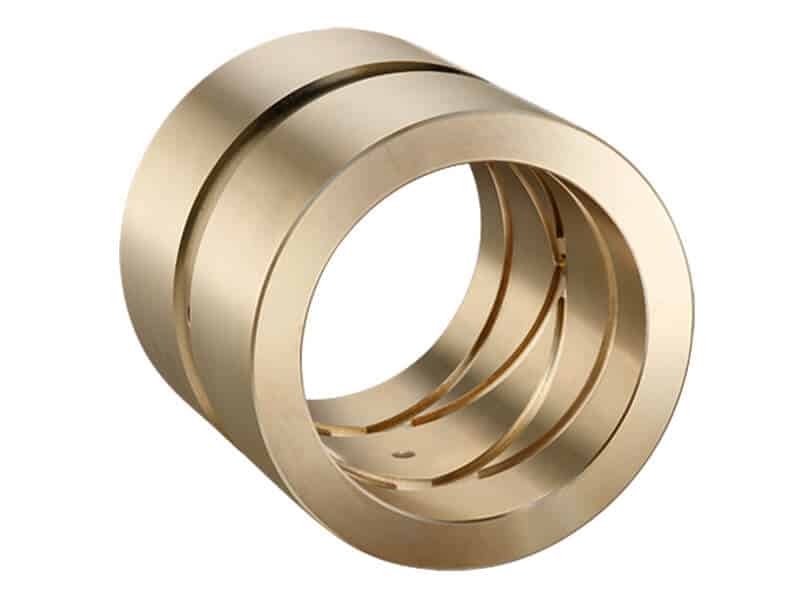
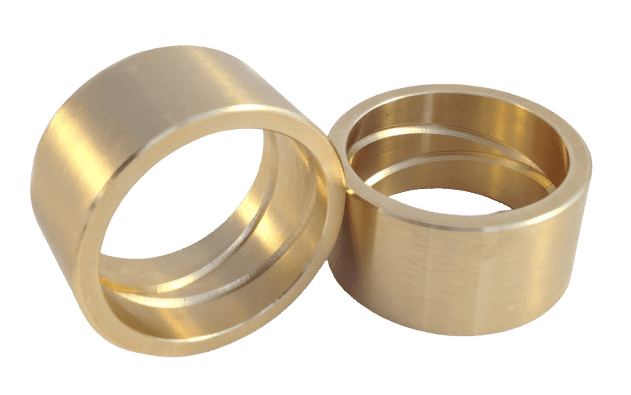
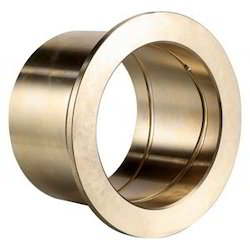
Manganese Bronze Bushings: Reliable from production to delivery, offering a durable, self‑lubricating design.
Bronzelube.com provides high-quality manganese bronze bushing parts and services, including C86300 (SAE 430B CuZn25Al5Fe3Mn4) bronze bushing slide bearings from China. Your Metal Experts, Making a Lasting Difference, manufactures essential metal components that power, protect, and connect people and businesses worldwide.
Bronze is the alloy of bearings. Bearings are usually made of bronze because of its resistance to wear and corrosion. Bronze is a copper alloy that usually contains tin, but may also contain other metals such as zinc or lead. These properties of bronze make it an ideal material for bearings that can withstand high loads and frictions. Bearings are used in various mechanical devices to reduce friction, thereby increasing efficiency and prolonging the service life of the equipment.
Quality for Manganese Bronze Bushings
Manganese bronze bushings offer high-quality solutions that fulfill your requirements. Bronze alloy, manganese bronze bushing bearings, bronze material properties, composition of bronze, bronze vs steel bushings.
Custom Manganese Bronze Bushings
Manganese bronze bushing bearings with precision-machined tolerances. Low minimum order value, small quantities, and fast delivery.
Standard Cast Bearing in Stock
Optimize your performance with our reliable bushing products. Click here to explore our selection and learn how to choose the right material!
C86300 Manganese Bronze Bushing
Manganese Bronze is a copper-zinc alloy containing small amounts of manganese, aluminum, and iron, offered in various sizes. Expert guidance is available.
Bronze Bushing Material
Material Selection Guide, Fast Shipping! Request a Quote! Browse All Products!
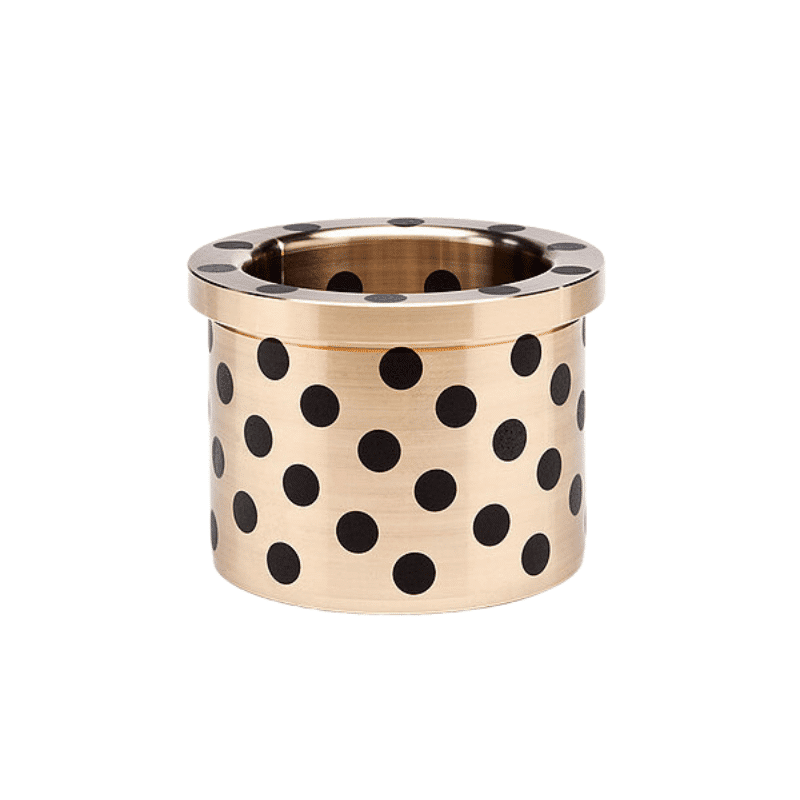
Manganese bronze bushings improve the durability of machinery.
Manganese bronze bushings offer durability and reliability for industrial applications that demand wear, corrosion, and high-temperature resistance. Their unique properties make them ideal for industries such as construction, mining, marine, and steel.
Manganese bronze alloys can withstand high loads and speeds.
Manganese Bronze Bushings: A Guide to Various Bronze Alloys
For customized, high-quality manganese bronze bushings, you’ve come to the right place. Our expert team is committed to delivering industry-leading self-lubricating manganese bronze bushing and bearing solutions.

